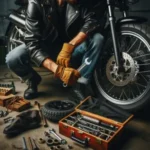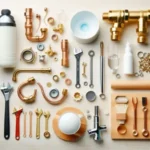Embarking on the journey of DIY projects can be both exhilarating and intimidating, especially for beginners eager to unleash their creativity and craftsmanship.
Whether you’re looking to transform a room, tackle small repairs, or craft unique decor, having the right tools at your disposal is crucial to your success. In this comprehensive guide, we will explore the essential tools every beginner DIYer should own, ensuring you’re equipped to take on a variety of projects with confidence and ease. From the versatile hammer and trusty screwdriver to innovative gadgets that can elevate your handiwork, each tool serves as a building block in your DIY toolkit. Join us as we delve into the must-have items that will not only simplify your tasks but also inspire you to tackle your next project like a pro!
1. Introduction to DIY: Why Every Beginner Should Start

In the world of home improvement and creative projects, the do-it-yourself (DIY) movement has gained remarkable traction, encouraging individuals to take control of their spaces and express their creativity. For beginners, diving into DIY can seem daunting at first, but the rewards are plentiful and well worth the effort. Not only does embracing DIY empower you to transform your home with personal touches, but it also cultivates a sense of accomplishment and self-sufficiency.
Starting your DIY journey opens the door to a wealth of opportunities. Whether you’re looking to spruce up your living room with a handmade shelf, tackle that long-overdue garden project, or even create personalized gifts for loved ones, the possibilities are endless. It’s about more than just home improvement; it’s about harnessing your creativity and learning new skills along the way. Each project completed, no matter how small, builds your confidence and enhances your problem-solving abilities, making you more equipped for future endeavors.
Moreover, DIY is a fantastic way to save money. Instead of hiring professionals for every little task, you can tackle many projects on your own with just a few essential tools and a bit of guidance. As you gain experience, you’ll discover that many projects can be completed for a fraction of the cost, allowing you to invest your savings into even more ambitious undertakings.
In this comprehensive guide, we’ll explore the essential tools every beginner DIYer should own, ensuring that you are well-equipped to embark on this rewarding journey. From the basic toolkit to specialized equipment, we’ll break down what you need to get started and help you build a solid foundation for your DIY adventures. So grab your safety goggles, roll up your sleeves, and let’s explore the exciting world of DIY!
2. Safety First: Essential Safety Gear for DIY Projects
When diving into the world of DIY, safety should always be your top priority. Whether you’re tackling small home repairs or embarking on ambitious renovation projects, investing in essential safety gear is crucial to protect yourself from potential hazards. Here’s a breakdown of the must-have safety equipment every beginner DIYer should own.
**1. Safety Glasses:** One of the simplest yet most effective pieces of safety gear, safety glasses shield your eyes from flying debris, dust, and harmful vapors. Look for a pair that fits comfortably and provides a snug seal around your eyes. Whether you’re drilling, sanding, or cutting, your eyes deserve protection.
**2. Hearing Protection:** Power tools can be loud, and prolonged exposure to high decibel levels can lead to hearing loss. Invest in a good pair of earplugs or earmuffs to minimize noise pollution, especially when using saws, drills, or other heavy machinery. Not only will this help preserve your hearing, but it will also allow you to focus better on your task.
**3. Dust Masks or Respirators:** Dust and fumes can pose serious health risks, particularly when working with materials like wood, drywall, or certain chemicals. A simple dust mask can filter out large particles, but for more toxic substances, consider a respirator that offers a higher level of filtration. Make sure it fits properly to ensure effective protection.
**4. Work Gloves:** Protecting your hands is essential when working with tools and materials. Choose work gloves that offer a good grip and are made from durable materials. Whether you’re handling rough wood, sharp tools, or hot surfaces, gloves provide the necessary barrier against cuts, scrapes, and burns.
**5. Steel-Toed Boots:** If you’re going to be moving heavy materials or using tools that could fall, steel-toed boots are a must. They protect your feet from heavy objects and provide additional support and stability, reducing the risk of injuries.
**6. First Aid Kit:** Accidents happen, even with the best precautions. Having a well-stocked first aid kit on hand ensures you’re equipped to handle minor injuries, from cuts and bruises to more serious mishaps. Make sure to include adhesive bandages, antiseptic wipes, gauze, and any personal medications you might need.
**7. High-Visibility Vest:** If you’re working outdoors or in low-light conditions, a high-visibility vest can help ensure you’re seen, especially if you’re sharing your workspace with others. This is particularly important during larger projects or when operating near traffic.
By equipping yourself with these essential safety tools, you’ll not only make your DIY experience safer but also more enjoyable. Always remember, taking the time to protect yourself allows you to focus on your projects with confidence and creativity!
3. Hand Tools Every Beginner Should Have
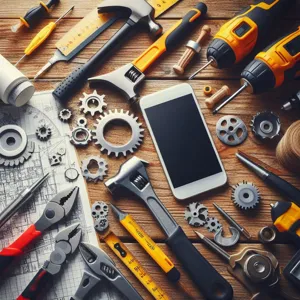
When embarking on your DIY journey, having the right hand tools is essential to ensure not only efficiency but also the quality of your projects. A well-equipped toolbox can empower you to tackle a variety of tasks, from simple repairs to more intricate creations. Here’s a comprehensive list of hand tools every beginner should consider adding to their toolkit.
**1. Claw Hammer:** The backbone of any DIY toolkit, a claw hammer is indispensable for driving nails into wood and for removing them when necessary. Opt for a hammer that feels comfortable in your hand and has a good weight balance for optimal control.
**2. Screwdriver Set:** A versatile screwdriver set that includes both flathead and Phillips-head screwdrivers is crucial. Look for a set with varying sizes to accommodate different screws. Magnetic tips can also be a great feature, making it easier to hold screws in place while you work.
**3. Tape Measure:** Precision is key in DIY, and a sturdy tape measure ensures you take accurate measurements every time. A 25-foot tape is a common choice for beginners, as it strikes a balance between portability and reach.
**4. Utility Knife:** A reliable utility knife is a must-have for cutting various materials, from cardboard to rope. Look for a knife with a retractable blade for safety and ease of use, as well as a comfortable grip for those extended projects.
**5. Pliers:** A pair of pliers can provide a strong grip for holding, twisting, or cutting wires and small objects. Needle-nose pliers are particularly useful for reaching into tight spaces, while standard pliers can handle general tasks.
**6. Level:** Ensuring that your projects are straight and level is crucial for both aesthetics and functionality. A simple bubble level can help you achieve perfectly aligned shelves, frames, or fixtures.
**7. Adjustable Wrench:** An adjustable wrench is invaluable for loosening or tightening nuts and bolts of various sizes. Its versatility makes it a staple in any beginner’s toolkit, allowing you to tackle plumbing tasks or furniture assembly with ease.
**8. Safety Gear:** While not a traditional hand tool, investing in safety gear is essential. Safety goggles protect your eyes from debris, while gloves can prevent cuts and blisters during your DIY adventures.
By equipping yourself with these fundamental hand tools, you’ll be well-prepared to handle a wide range of projects, from minor repairs to creative endeavors. As you gain experience and confidence, you can expand your toolkit with specialized tools tailored to your specific interests, but starting with these essentials will set you on the right path to successful DIYing.
– 3.1. Hammer
A hammer is perhaps the quintessential tool in any DIY enthusiast’s arsenal, serving as both a symbol and a cornerstone of craftsmanship. Whether you’re hanging pictures, assembling furniture, or tackling home repairs, a reliable hammer is indispensable.
When selecting a hammer, consider the weight and type that best suits your projects. For general DIY tasks, a standard claw hammer—typically weighing between 16 and 20 ounces—is ideal. This versatile tool features a flat striking surface on one end for driving nails into wood and a curved claw on the other for pulling them out with ease. The balance of weight and usability makes it perfect for both beginners and seasoned DIYers alike.
The handle material also plays a crucial role in comfort and durability. Wooden handles offer a classic feel, while fiberglass or rubber grips provide shock absorption and a non-slip surface, reducing hand fatigue during extended use. Take the time to find a hammer that feels good in your hand, as this will make your DIY projects much more enjoyable.
As you embark on your DIY journey, remember that a hammer isn’t just a tool; it’s an extension of your creativity and capability. With the right hammer in hand, you’ll be empowered to transform your ideas into reality, one nail at a time. So, whether you’re crafting a beautiful piece of furniture or renovating a room, don’t underestimate the power of this simple yet essential tool.
– 3.2. Screwdrivers
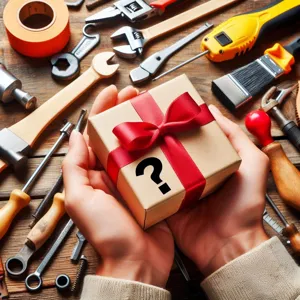
### 3.2 Screwdrivers
A sturdy and reliable set of screwdrivers is an absolute essential for any beginner DIYer. These versatile tools are not only crucial for assembling furniture and tightening loose screws but also play a vital role in countless home improvement projects. When selecting screwdrivers, it’s important to consider both the variety and quality of the tools in your kit.
Start with a set that includes both flathead and Phillips screwdrivers in various sizes. Flathead screwdrivers, with their single flat blade, are perfect for slotted screws, while Phillips screwdrivers, characterized by their cross-shaped tip, provide better grip and torque. Investing in magnetic screwdrivers can also be a game-changer; the magnetic tip helps hold screws in place, making it easier to work in tight spaces without the frustration of dropped fasteners.
It’s also worth considering a ratcheting screwdriver, which allows for quick and efficient tightening and loosening of screws without the need to reposition the tool after each turn. For those who want to take their DIY skills to the next level, a multi-bit screwdriver can be incredibly handy. This tool features interchangeable bits, allowing you to tackle various screw sizes and types without cluttering your workspace with multiple tools.
Remember to pay attention to the handle design as well. Ergonomic handles provide a comfortable grip, reducing hand fatigue during longer projects. A well-balanced screwdriver not only enhances control but also makes it easier to apply the necessary force without straining your wrist.
Ultimately, having a reliable set of screwdrivers will empower you to tackle everything from simple repairs to complex installations with confidence. As you embark on your DIY journey, make sure to keep these essential tools within easy reach, and you’ll find that many of your projects will become far less daunting!
– 3.3. Pliers
### 3.3. Pliers
Pliers are a cornerstone of any DIY toolkit, offering versatility and grip that can handle a multitude of tasks. From bending and twisting wires to gripping and pulling objects, these handy tools come in various shapes and sizes, each designed for specific functions.
**Types of Pliers:**
1. **Needle-Nose Pliers:** With their long, tapered jaws, needle-nose pliers are perfect for reaching into tight spaces and manipulating small objects. Whether you’re working with delicate electronics or intricate jewelry designs, these pliers provide the precision needed for intricate tasks.
2. **Slip-Joint Pliers:** Often referred to as adjustable pliers, these feature a movable pivot point that allows you to adjust the jaw width, making them ideal for gripping items of different sizes. They are particularly useful for plumbing tasks or when you need a stronger grip on a larger object.
3. **Cutting Pliers:** Equipped with sharp edges, cutting pliers are designed for snipping wires and cables. They come in handy for electrical projects, allowing you to cleanly cut through materials without fraying or damaging them.
4. **Locking Pliers:** Also known as Vise-Grips, these pliers can lock onto an object, providing a secure grip without requiring constant pressure from your hand. They are excellent for clamping materials together or holding tight in awkward positions while you work on a project.
**Why You Need Pliers:**
Having pliers in your toolbox offers you the flexibility to tackle a wide range of DIY projects with confidence. They empower you to handle tasks that require precision, strength, or a delicate touch. Whether you’re assembling furniture, fixing appliances, or crafting your next home décor project, pliers can be the unsung heroes of your toolkit.
**Care and Maintenance:**
To ensure your pliers last for years, it’s essential to keep them clean and lubricated. After each use, wipe down the jaws and joints to remove debris and prevent rust. Regularly check for any signs of wear, and if you notice any rust, use a wire brush or rust remover to clean them up. Properly maintaining your tools not only extends their life but also enhances their performance, helping you get the job done seamlessly.
In summary, pliers are an indispensable tool for any beginner DIYer. Their ability to grip, twist, cut, and hold makes them a must-have in your growing collection, paving the way for successful and enjoyable projects.
– 3.4. Measuring Tape
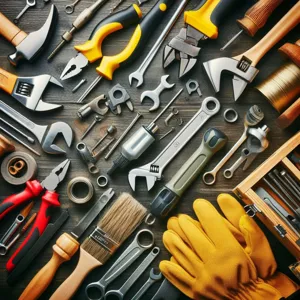
### 3.4. Measuring Tape
A measuring tape is an indispensable tool for any DIY enthusiast, serving as the backbone of every successful project. Whether you’re hanging shelves, laying flooring, or crafting custom furniture, precise measurements are crucial to achieving a professional finish, and a measuring tape is your best ally in ensuring accuracy.
Typically extending up to 25 feet or more, a standard measuring tape features a flexible metal or fiberglass blade, allowing you to easily navigate around corners and awkward spaces. The markings on the tape are usually in both inches and centimeters, making it versatile for various projects and user preferences. Look for a model with a locking mechanism, which will hold your measurement in place, providing you with the stability needed when marking cuts or drilling holes.
Moreover, the durability of a measuring tape is an essential factor to consider. Opt for one that’s sturdy and can withstand the wear and tear of frequent use. Some tapes even come with added features like a magnetic hook or an easy-to-read standout, which can make measuring larger distances much easier.
In addition to its primary function, a measuring tape can also spark creativity. As you measure out spaces and envision your projects, you may discover new possibilities for layout, design, and functionality. Whether you’re a weekend warrior or diving into more ambitious home improvement projects, having a reliable measuring tape on hand will not only save you time but will also prevent costly mistakes. So, make sure this versatile tool is part of your essential DIY toolkit, and watch your projects come to life with precision and flair!
4. Power Tools for the Aspiring DIYer
When it comes to tackling more ambitious projects, power tools are game changers for the aspiring DIYer. These tools not only save time and effort but also expand the range of tasks you can confidently undertake. As you venture into the realm of home improvement, having the right power tools can make all the difference in achieving professional-looking results.
**1. Cordless Drill/Driver:** This versatile tool should be at the top of your list. Whether you’re assembling furniture, hanging shelves, or performing minor renovations, a cordless drill makes drilling holes and driving screws a breeze. Opt for a model with adjustable speed settings and a range of drill bits for added flexibility.
**2. Circular Saw:** Perfect for cutting lumber, plywood, and other materials with precision, a circular saw is indispensable for larger projects. Its portability allows you to work both indoors and outdoors, and its ability to make straight cuts quickly can save you hours of manual labor.
**3. Jigsaw:** For intricate cuts and curves, a jigsaw is the tool to have. This handheld saw allows you to create detailed shapes and designs in wood, plastic, or metal. With various blade types available, you can tackle a wide variety of materials, making it a must-have for creative DIY projects.
**4. Sander:** Achieving a smooth finish is essential in any DIY project. A power sander, whether it’s a belt sander for large surfaces or a palm sander for finer details, will help you eliminate rough edges and prepare your materials for painting or staining.
**5. Impact Driver:** When it comes to driving long screws or tackling tough materials, an impact driver is a powerhouse. It delivers high torque and rapid bursts of power, making it easier to drive screws without stripping them. This tool is particularly useful for outdoor projects or heavy-duty applications.
**6. Oscillating Multi-Tool:** This multi-functional tool can cut, sand, scrape, and grind, making it remarkably versatile. It’s perfect for tight spaces and detailed work, such as removing grout or trimming door frames. The oscillating motion reduces the risk of damaging surrounding materials, making it a safe choice for beginners.
As you begin your DIY journey, investing in these essential power tools will not only enhance your efficiency but also empower you to take on a broader range of projects. With practice and the right tools in hand, you’ll find that your confidence and skills will grow, transforming your home and projects one task at a time.
– 4.1. Cordless Drill
### 4.1. Cordless Drill
A cordless drill is an indispensable tool that every DIY beginner should consider as a cornerstone of their toolkit. Versatile and easy to use, this powerful device simplifies a variety of tasks, from assembling furniture and installing shelves to drilling holes in walls and tightening screws. The freedom of movement that a cordless drill provides—without the hassle of tangled cords or needing to find a power outlet—makes it an ideal companion for both indoor and outdoor projects.
When selecting a cordless drill, look for a model that strikes a balance between power and weight. A lightweight drill will be easier to handle for extended periods, while one with sufficient torque will ensure that it can tackle tougher jobs without straining. Many models come with adjustable speed settings, allowing you to switch between a slow speed for precise drilling and a higher speed for faster tasks.
Another key feature to consider is the battery life. Opt for a drill with a lithium-ion battery, which offers a longer lifespan and faster charging times compared to traditional batteries. Some drills come with interchangeable battery packs, ensuring you won’t be left stuck mid-project with a dead battery.
Additionally, a cordless drill often includes a variety of drill bits and driver heads, expanding its usability for different materials and tasks. Investing in a set with multiple attachments will enhance your toolkit and enable you to tackle a wider range of projects right from the start.
In summary, a cordless drill is not just a tool; it’s a gateway to unlocking your DIY potential. With its ease of use and multifunctionality, it empowers you to take on projects with confidence and creativity, ensuring that you can efficiently bring your ideas to life. Whether you’re hanging art, assembling that bookshelf you’ve been eyeing, or tackling home repairs, having a reliable cordless drill by your side will make all the difference.
– 4.2. Circular Saw
### 4.2 Circular Saw
A circular saw is an essential tool that every beginner DIYer should have in their arsenal. Renowned for its versatility and power, this tool can make quick work of a variety of cutting tasks, from lumber and plywood to metal and plastic. The circular saw is designed with a toothed blade that spins rapidly, allowing it to slice through materials with precision and ease.
For the novice, the circular saw might seem intimidating at first glance, but its user-friendly design makes it accessible to all skill levels. Most models feature a comfortable grip and lightweight construction, which can help reduce fatigue during extended use. Additionally, many circular saws come with adjustable cutting depths and angles, offering you the flexibility to tackle different projects, whether you’re building a deck, crafting furniture, or simply making home repairs.
When selecting a circular saw, consider the size of blade you need. Typically, a 7 1/4-inch blade is the most common and offers a good balance between power and portability. Furthermore, look for features like a laser guide or LED light, which can greatly improve accuracy when cutting.
Safety is paramount when using a circular saw, so ensure you invest in protective gear, such as safety goggles and hearing protection. Before you begin any project, always be sure to read the manufacturer’s instructions and familiarize yourself with the tool’s settings and controls.
By incorporating a circular saw into your DIY toolkit, you’ll not only enhance your cutting capabilities but also open the door to a world of creative possibilities. Whether you’re planning ambitious renovations or simple home improvements, this tool is sure to become a go-to favorite in your DIY endeavors.
– 4.3. Sander
### 4.3. Sander
A sander is an indispensable tool for any DIY enthusiast looking to achieve that flawless finish on their projects. Whether you’re working with wood, metal, or even plastic, a sander can make all the difference in the quality of your work. For beginners, investing in a versatile sander can save you a considerable amount of time and effort while ensuring a professional-looking result.
There are several types of sanders available, but two of the most beginner-friendly options are the orbital sander and the detail sander. An orbital sander is perfect for larger surfaces, like tabletops or cabinets, as it uses circular sanding pads to smooth out rough areas and prepare surfaces for painting or staining. Its random orbit motion helps to prevent swirl marks, making it ideal for achieving a smooth finish on all kinds of wood.
On the other hand, a detail sander is designed for those hard-to-reach corners and intricate areas. Its triangular shape allows you to navigate tight spaces with ease, making it perfect for sanding furniture edges, intricate moldings, or the seams of your DIY projects. With the right sandpaper grits, you can transition from rough sanding to fine finishing, ensuring every nook and cranny is perfectly smooth.
When using a sander, remember to wear appropriate safety gear, such as a dust mask and goggles, to protect yourself from fine particles. Additionally, always follow the manufacturer’s instructions for optimal performance and safety. As you become more experienced, you’ll find that a sander is not just a tool, but an extension of your creative vision, allowing you to transform raw materials into beautiful finished pieces. Embrace the power of sanding, and watch as your DIY projects come to life with a polished touch!
5. Essential Hardware and Fasteners
When embarking on your DIY journey, having the right hardware and fasteners at your fingertips is crucial for ensuring your projects are sturdy, safe, and aesthetically pleasing. These small yet mighty components often make the difference between a well-finished project and a flimsily assembled piece that falls apart at the slightest touch.
**Nails and Screws:** Start with a diverse collection of nails and screws in various sizes and types. Common wood screws, drywall screws, and finishing nails are essential for a range of tasks, from assembling furniture to securing wall fixtures. Consider investing in a screw organizer to keep them sorted and accessible.
**Anchors and Wall Fasteners:** For projects that require mounting items to walls, such as shelves or picture frames, wall anchors are indispensable. They provide extra support and prevent screws from pulling out of the wall. Choose between plastic, metal, or toggle bolts, depending on the weight of the items you’re hanging.
**Brackets and Hangers:** These hardware pieces are essential for adding strength and support to your projects. Corner brackets and L-brackets can reinforce joints, while shelf brackets can help you create sturdy shelving solutions. Don’t overlook the importance of picture hangers and ceiling hooks for your decorative needs.
**Adhesives and Sealants:** Sometimes, hardware alone isn’t enough. A good adhesive can be a game-changer. Wood glue, epoxy, and super glue each have their uses, allowing for strong bonds in different materials. Sealants, such as caulking, are perfect for filling gaps and providing a finished look, especially in kitchen and bathroom projects.
**Organizational Tools:** Lastly, invest in a sturdy toolbox or a rolling organizer to keep all your hardware and fasteners neatly stored. An organized workspace not only saves you time when searching for supplies but also contributes to a more efficient and enjoyable DIY experience.
By equipping yourself with these essential hardware and fasteners, you’ll have the foundational tools necessary to tackle a wide variety of DIY projects with confidence and skill. Whether you’re assembling a bookshelf or hanging a new mirror, the right hardware will ensure your hard work stands the test of time.
6. Storage Solutions for DIY Tools
When diving into the world of DIY, having the right tools is only part of the equation; how you store and organize those tools can significantly impact your efficiency and enjoyment of projects. Proper storage solutions for DIY tools not only keep your workspace tidy but also ensure that you can easily find what you need when creativity strikes.
Start by assessing the types and quantities of tools you have. A portable toolbox is an excellent first step, allowing you to transport your essential tools to various locations around the house or even off-site projects. Look for one with a sturdy handle and compartments to keep smaller items like screwdrivers and pliers organized. For larger tools, such as power drills and saws, consider investing in a rolling tool chest. These come with multiple drawers and can easily be moved around, providing convenient access to your tools while keeping them secure and protected.
Magnetic strips and pegboards are fantastic for wall storage, enabling you to display frequently-used tools within arm’s reach. Simply mount a pegboard above your workbench, and use hooks and shelves to hang everything from hammers to tape measures. This not only maximizes vertical space but also adds a touch of organization and aesthetic appeal to your workspace.
Don’t overlook the importance of labeling. Clearly labeling boxes and bins can save you time and frustration, especially when you’re knee-deep in a project and need to grab the right tool quickly. Use clear containers for small parts like screws and nails, and make sure they are easy to see through.
Finally, consider modular storage solutions that can be customized to fit your specific needs. Whether you’re stacking bins or using interlocking storage units, modular systems allow you to adapt your storage as your tool collection grows.
In essence, having a well-thought-out storage strategy will not only help you maintain an organized workspace but also enhance your overall DIY experience, making each project more enjoyable and less stressful. With these storage solutions in place, you’ll be ready to tackle any challenge that comes your way!
7. Organizing Your Workspace
A well-organized workspace is the cornerstone of any successful DIY project, especially for beginners who may feel overwhelmed by the variety of tools and materials at their disposal. An organized workspace not only enhances productivity but also promotes safety and fosters creativity. To create an efficient environment, begin by designating a specific area in your home for your DIY projects. This space should be well-lit and have enough room to accommodate your tools, materials, and any projects you’re currently working on.
Once you have your designated area, it’s time to tackle the organization. Start with a sturdy workbench or table where you can comfortably perform your tasks. Invest in storage solutions such as toolboxes, pegboards, or shelving units to keep your tools easily accessible and neatly arranged. Categorize your tools by type—hand tools in one section, power tools in another, and smaller items like screws and nails in labeled containers. Consider using clear bins or jars for visibility, allowing you to quickly find what you need without rummaging through clutter.
Don’t forget about the importance of maintaining a clean and tidy workspace. Regularly declutter and remove any unused items that might distract you from your current project. Implement a ‘clean as you go’ policy, where you put tools back in their designated spots immediately after use. This habit not only keeps your workspace organized but also helps prevent accidents caused by misplaced tools.
Finally, personalize your workspace to inspire creativity. Add a splash of color with wall art or motivational quotes, and incorporate plants to bring a bit of nature indoors. An organized and inviting workspace will not only make your DIY endeavors more enjoyable but will also encourage you to tackle more ambitious projects as your skills grow. Remember, a little organization goes a long way in turning your DIY dreams into reality!
8. Must-Have Materials for Various Projects
When embarking on your DIY journey, having a well-stocked arsenal of materials can make all the difference in the success and enjoyment of your projects. Beyond just tools, the right materials serve as the foundation for everything you create. Here are some must-have materials that every beginner DIYer should consider keeping on hand for a variety of projects:
**1. Wood:** Whether you’re building a simple shelf, crafting a birdhouse, or constructing furniture, having a selection of wood types—like pine for its affordability and versatility, or plywood for those larger projects—will give you the flexibility to tackle numerous tasks.
**2. Paint and Stains:** A fresh coat of paint or a beautiful stain can transform any project. Stock up on a range of colors and finishes, including primers, spray paints, and sealants to protect your finished work. Remember that samples can be a great way to test colors before committing to a larger purchase!
**3. Adhesives:** From wood glue for furniture construction to super glue for quick fixes, a variety of adhesives is essential. Don’t forget about specialty glues like epoxy for tougher materials or fabric glue for textile projects.
**4. Fasteners:** Keep a supply of screws, nails, and anchors in various sizes. These small but mighty components are crucial for joining pieces together securely. A handy organizer can help keep them sorted and easy to find.
**5. Fabrics and Textiles:** If you’re venturing into sewing or upholstery, a selection of fabrics ranging from cottons to heavier materials like canvas will allow you to experiment with different projects, from curtains to cushions.
**6. Duct Tape and Painter’s Tape:** These are often overlooked but incredibly useful in countless scenarios. Duct tape is perfect for quick repairs, while painter’s tape helps achieve clean lines when painting or staining.
**7. Safety Gear:** While technically not a “material” in the traditional sense, safety gear such as gloves, goggles, and masks is essential for protecting yourself during any DIY project. Always prioritize safety to ensure that your creative endeavors are enjoyable and hazard-free.
With these essential materials at your fingertips, you’ll be well-prepared to embark on a wide variety of DIY projects. The right materials not only enhance your capabilities but also inspire creativity, allowing you to bring your unique ideas to life with confidence. Happy crafting!
9. Resources for Learning DIY Skills
As a beginner DIYer, one of the most empowering steps you can take is to invest in your knowledge. The world of DIY is vast and full of possibilities, and understanding the foundations of various skills can turn a daunting project into a rewarding experience. Fortunately, a wealth of resources is available to help you hone your DIY skills and gain confidence in your abilities.
One of the best ways to start is by exploring online tutorials and videos. Platforms like YouTube are treasure troves of DIY content, featuring step-by-step guides for everything from basic carpentry to complex plumbing. Many seasoned DIY enthusiasts share their tips, tricks, and even mistakes, offering invaluable insights that can save you time and frustration. Look for channels with high ratings and substantial followings, as these creators have often refined their methods through experience.
In addition to video content, online forums and community groups can be incredibly beneficial. Websites like Reddit and DIY-specific forums allow you to connect with other DIYers who can provide advice, share their experiences, and answer your burning questions. Engaging in these communities not only enhances your knowledge but can also inspire you to tackle new projects you might have previously thought were beyond your capabilities.
Books and magazines dedicated to DIY projects are also excellent resources. They often cover a wide range of topics, from basic home repairs to intricate craft projects, and can serve as a handy reference guide as you work. Look for books that are highly rated and come with clear illustrations and easy-to-follow instructions.
Lastly, don’t underestimate the power of local workshops or classes. Many hardware stores, community colleges, and even craft supply shops offer hands-on sessions where you can learn directly from experienced instructors. These opportunities allow you to practice your skills in a supportive environment, ask questions in real-time, and connect with fellow DIY enthusiasts.
By leveraging these diverse resources, you’ll equip yourself with the knowledge and confidence needed to tackle any project that comes your way. As you learn and grow, you’ll find that each new skill opens the door to even more complex and fulfilling DIY endeavors. So gather your tools, dive into these resources, and get ready to unleash your inner DIY master!
10. Budgeting for Your DIY Toolkit
When it comes to embarking on your DIY journey, budgeting for your toolkit is just as crucial as selecting the right tools themselves. A well-planned budget not only helps you avoid overspending but also ensures that you acquire the essential items that will serve you well on countless projects to come.
Start by assessing the types of projects you’re most interested in tackling. Are you leaning towards woodworking, home repairs, or perhaps gardening? Identifying your primary focus will guide your spending and prevent you from purchasing tools that may end up collecting dust.
Next, create a list of must-have tools based on your project preferences. Essentials like a versatile drill, a set of screwdrivers, a reliable tape measure, and a sturdy hammer should be at the top of your list. As you compile your toolkit, consider investing in quality over quantity. High-quality tools are often more durable and effective, which can save you money in the long run by reducing the need for replacements.
It’s also wise to explore second-hand options or discounted tools to stretch your budget further. Local classifieds, garage sales, or dedicated online marketplaces can yield fantastic finds that might be just as good as new. Additionally, keep an eye out for seasonal sales or promotions at your local hardware store, which can provide opportunities to snag the critical tools you need at a lower cost.
Lastly, don’t forget to allocate some funds for maintenance supplies, such as oil for tool upkeep or storage solutions to keep your workspace organized. A well-maintained toolkit not only enhances your efficiency but also boosts your confidence as you dive into new projects.
By budgeting thoughtfully and prioritizing the right tools, you’ll set the stage for a fulfilling DIY experience filled with creativity and accomplishment. With every project you complete, you’ll find your toolkit evolving, reflecting your growing skills and aspirations as a DIY enthusiast.
11. Maintaining Your Tools for Longevity
Maintaining your tools for longevity is a critical aspect of any DIYer’s journey that often goes overlooked. After investing time and money into selecting the right tools, ensuring they remain in peak condition can save you from unnecessary expenses down the road and enhance your overall crafting experience.
First and foremost, keep your tools clean after each use. Whether it’s wiping down your hammer, sweeping debris from your saw, or cleaning paint off your brushes, a quick cleanup can prevent rust, corrosion, and buildup that can impair functionality. For power tools, consult the manufacturer’s guidelines for specifics on cleaning and maintenance, as each tool may have unique requirements.
Proper storage also plays a vital role in tool longevity. Create a dedicated space for your tools, using pegboards, toolboxes, or magnetic strips to keep them organized and easily accessible. This not only minimizes the risk of damage but also protects them from the elements. For instance, storing your tools in a dry environment prevents moisture from causing rust, while keeping them out of direct sunlight can protect plastic parts from fading or warping.
Moreover, regular inspections are essential. Make it a habit to check your tools periodically for any signs of wear and tear. Look for dull blades that need sharpening, screws that require tightening, or cords that show signs of fraying. Addressing these issues early can prevent more significant problems and potentially costly repairs.
Lastly, consider investing in a basic tool maintenance kit, which may include items such as lubricants, rust removers, and sharpening tools. These essentials make it easier to perform routine maintenance at home, ensuring that your tools are always ready for your next project.
By adopting these simple maintenance practices, you can extend the life of your tools, improve their performance, and ultimately enjoy your DIY endeavors to the fullest. Remember, a well-maintained tool is not just a tool; it’s a reliable partner in your creative journey!
12. Expanding Your Toolkit as You Grow
As you embark on your DIY journey, starting with a basic toolkit is essential. However, as your skills develop and your projects become more ambitious, expanding your toolkit will empower you to tackle a wider range of tasks with confidence and ease. Here are some key tools and equipment to consider adding to your arsenal as you grow in your DIY endeavors.
First, consider investing in a quality set of power tools. A cordless drill is a must-have for any DIYer, allowing you to effortlessly drive screws and drill holes in various materials. As you progress, a circular saw and a jigsaw can open up new possibilities for woodworking projects, enabling you to make precise cuts and intricate designs with ease.
Next, think about adding specialized hand tools that can enhance your capabilities. A chisel set is invaluable for fine woodworking, allowing you to carve and shape wood to your liking. Similarly, a good quality level ensures that your installations are straight and true, whether you’re hanging shelves or framing pictures.
Safety gear should also be a priority as you expand your toolkit. Investing in a sturdy pair of safety goggles and a quality dust mask will protect your eyes and lungs from debris and harmful particles, allowing you to work safely and comfortably.
Additionally, consider organization tools like a toolbox or pegboard. Keeping your tools neatly stored and easily accessible will save you time and frustration when tackling new projects. As you continue to grow, you might also explore specialty tools like a stud finder for wall projects or a heat gun for paint stripping, further enhancing your DIY skill set.
Remember, the key to expanding your toolkit is to invest in quality over quantity. Choose tools that are durable and versatile, allowing you to get the most out of your purchases. As you gain experience and tackle more complex projects, your growing toolkit will empower your creativity and transform the way you approach DIY tasks. Embrace the journey, and watch your skills flourish as your toolkit evolves alongside your passion for creating!
13. Conclusion: Taking the First Step in DIY
Embarking on your DIY journey can be both exciting and daunting, but with the right tools and a positive mindset, you’re well on your way to transforming your creative ideas into tangible projects. As we’ve explored in this guide, having a solid toolkit is essential for any beginner DIYer. From basic hand tools like hammers and screwdrivers to more specialized equipment like levelers and safety gear, each item plays a vital role in helping you achieve your goals.
Remember, the first step in any DIY project is not just gathering tools; it’s about embracing the learning process. Mistakes will happen, and that’s part of the journey. Each error offers you a valuable lesson, building your skills and confidence as you tackle more complex tasks. Don’t be afraid to start small—simple projects like building a bookshelf or creating custom wall art can provide a satisfying introduction to the world of DIY.
Moreover, take advantage of online resources, tutorials, and community forums to gather inspiration and advice. Sharing your projects and experiences with fellow DIY enthusiasts can not only enhance your skills but also keep you motivated along the way.
In conclusion, the world of DIY is open to anyone willing to take the plunge. Equip yourself with the essential tools outlined in this guide, cultivate a spirit of curiosity, and let your creativity flourish. With every project, you’ll not only add to your toolkit but also build a wealth of knowledge and experience that will serve you well in all your future endeavors. So grab those tools, roll up your sleeves, and start creating—your DIY adventure awaits!
14. Bonus: Recommended Brands and Where to Buy
When diving into the world of DIY, having the right tools can make all the difference in your projects’ success and enjoyment. While we’ve explored various essential tools, it’s equally important to know where to find high-quality products at reasonable prices. Here’s a curated list of recommended brands and where to purchase them, ensuring you get the best value for your investment.
**1. Tool Brands**
– **DeWalt:** Renowned for their durability and reliability, DeWalt offers a vast range of power tools and hand tools ideal for both beginners and seasoned DIYers. Their cordless drill and impact driver kits are especially popular for home improvement projects.
– **Stanley:** A trusted name in hand tools, Stanley provides a wide selection of reliable items like tape measures, hammers, and screwdrivers. Their tools are not only affordable but also designed for longevity, making them perfect for beginners.
– **Milwaukee:** Known for their innovative power tools, Milwaukee is a favorite among those looking for cutting-edge technology and performance. Their M18 battery platform is excellent for anyone who needs a versatile and powerful toolset for various projects.
– **Ryobi:** If you’re interested in a budget-friendly option with a solid range of tools, Ryobi is an excellent choice. Their One+ system allows you to use the same battery across a variety of tools, making it a cost-effective solution for DIY enthusiasts.
**2. Where to Buy**
– **Home Improvement Stores:** Chains like Home Depot and Lowe’s offer a wide selection of tools from all the major brands. They often have sales, and you can find both in-store and online shopping options.
– **Online Retailers:** Websites like Amazon provide a vast array of tools, often at competitive prices. You’ll find customer reviews that can help guide your purchase decisions. Additionally, they frequently have deals on bundles that can save you money.
– **Specialty Tool Retailers:** Stores such as Ace Hardware and Northern Tool carry a range of both popular and specialty brands. These retailers can provide knowledgeable staff who can help you choose the right tools for your specific needs.
– **Local Hardware Stores:** Don’t overlook local hardware stores! They often carry quality tools and can provide personalized service. Plus, supporting local businesses helps foster community ties.
By investing in reputable brands and knowing where to shop, you’ll be well-equipped to tackle any DIY project that comes your way. Remember, the right tools paired with the right knowledge can transform your creative ideas into tangible realities, making your DIY journey even more rewarding. Happy building!
As we wrap up our comprehensive guide on the essential tools every beginner DIYer should own, we hope you feel inspired and equipped to embark on your creative projects with confidence. From the trusty tape measure to the versatile power drill, each tool plays a vital role in transforming your ideas into reality. Remember, the right tools not only enhance your efficiency but also make your DIY journey safer and more enjoyable. Whether you’re tackling a simple home repair or crafting a personalized piece of decor, having these essentials on hand will empower you to unleash your inner handyman or handywoman. So gather your tools, embrace the learning curve, and enjoy the satisfaction that comes from creating something uniquely yours. Happy DIYing!



